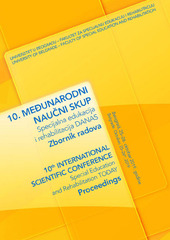Topografija samopovređivanja kod dece sa poremećajem autističkog spektra i dece sa intelektualnom ometenošću
Topography of self-injury in children with autism spectrum disorder and children with intellectual disability
| dc.contributor | Vuković, Mile | |
| dc.contributor | Žunić Pavlović, Vesna | |
| dc.contributor | Grbović, Aleksandra | |
| dc.contributor | Radovanović, Vesna | |
| dc.creator | Marković, Danijel | |
| dc.date.accessioned | 2021-12-24T11:22:11Z | |
| dc.date.available | 2021-12-24T11:22:11Z | |
| dc.date.issued | 2019 | |
| dc.identifier.isbn | 978-86-6203-129-7 | |
| dc.identifier.uri | http://rfasper.fasper.bg.ac.rs/handle/123456789/4098 | |
| dc.description.abstract | Samopovređivanje je ponašanje usmereno ka sopstvenom telu, koje je praćeno njegovim fizičkim oštećenjem. Postoji veliki broj topografija samopovređivanja kod dece sa poremećajem autističkog spektra (PAS) i dece sa intelektualnom ometenošću (IO), pri čemu se svako od njih ponaosob može samopovređivati na više različitih načina. Istraživanje ima za cilj da utvrdi topografiju samopovređivanja kod dece sa PAS i dece sa IO. Uzorak je formiran od 22 ispitanika sa PAS i pridruženom IO, uzrasta od 7 do 12,9 godina (AS = 9,72; SD = 1,74), i 30 ispitanika sa IO starosti od 7,1 do 12,1 godina (AS = 9,68; SD = 1,70). U oba slučaja se radi o ispitanicima sa težim oblicima IO. Topografija samopovređivanja je utvrđena primenom podskale Samopovređivanje iz Inventara problematičnog ponašanja, pri čemu su podaci dobijeni od roditelja. Samopovređivanje je prisutno kod 90,9% dece sa PAS, i kod nešto više od polovine (56,7%) dece sa IO. Prinošenje ustima ili gutanje nejestivih predmeta (pika) (65%) je najučestalija topografija samopovređivanja kod dece sa PAS, dok se među učestalije ubrajaju još i udaranje po glavi (50%) i drugim delovima tela (45%), grebanje (45%) i štipanje (40%). Kod dece sa IO, udaranje po glavi, prinošenje ustima ili gutanje nejestivih predmeta (pika), čupanje noktiju na prstima ruku i nogu, gutanje vazduha i čupanje kose su najzastupljenije topografije samopovređivanja, pri čemu je svaka od pomenutih, registrovana kod 41,2% ispitanika. Broj topografija samopovređivanja kod dece sa PAS kreće se između 1 i 10 (AS = 4,60; SD = 2,68), a u slučaju dece sa IO, od 1 do 9 (AS = 4,00; SD = 2,42). Uzrast statistički značajno i visoko korelira sa brojem topografija samopovređivanja (r = 0,61, p < 0,01), samo kod dece sa PAS. Neophodno je sagledati uticaj različitih činilaca koji mogu imati ulogu u nastanku i perzistiranju samopovređivanja, zatim, utvrditi funkciju samopovređivanja i primeniti bihevioralne strategije za njegovo preusmeravanje. | sr |
| dc.description.abstract | Self-injury is behavior directed towards one’s own body, followed by its physical damage. There is a large number of topography of self-injury in children with autism spectrum disorder (ASD) and children with intellectual disability (ID), whereby each of them individually, may self-injure in several different ways. The aim of the research was to determine the topography of self-injury in children with ASD and children with ID. The sample was formed from 22 subjects with ASD and associated ID, from 7 to 12.9 years of age (M = 9.72; SD = 1.74), and 30 subjects with ID, 7.1 to 12.1 years of age. In both cases, these people had more severe forms of ID. The topography of self-injury was determined by using the Self-injury subscale from the Behavior Problems Inventory, wherein the data was obtained from the parents. Self-injury was present in 90.9% of children with ASD, and in slightly more than half (56.7%) of children with ID. Mouthing or swallowing of non-food items (pica) (65%), was the most common topography of self-injury in children with ASD, while hitting on the head (50%) and other parts of the body (45%), scratching (45%) and pinching (40%) were among more frequent ones. In children with ID, hitting on the head, mouthing or swallowing of non-food items (pica), pulling out finger or toe nails, air swallowing and hear pulling were the most common topography of self-injury, with each of them registered in 41.2% of respondents. The number of topography of self-injury in children with ASD ranges between 1 and 10 (M = 4.60; SD = 2.68), and in children with ID, from 1 to 9 (M = 4.00; SD = 2.42). Age statistically significantly and highly correlated with the number of topography of self-injury (r = 0.61, p < 0.01), only in children with ASD. It is necessary to consider the influence of various factors that may play a role in the onset and persistence of self-injury, then, establish the function of self-injury and apply behavioral strategies for its redirection. | sr |
| dc.language.iso | sr | sr |
| dc.publisher | Univerzitet u Beogradu – Fakultet za specijalnu edukaciju i rehabilitaciju/ University of Belgrade – Faculty of Special Education and Rehabilitation | sr |
| dc.rights | openAccess | sr |
| dc.rights.uri | https://creativecommons.org/licenses/by-sa/4.0/ | |
| dc.source | Zbornik radova - 10. Međunarodni naučni skup „Specijalna edukacija i rehabilitacija danas“, Beograd, Srbija, 25–26. 10.2019. | sr |
| dc.subject | poremećaj autističkog spektra | sr |
| dc.subject | intelektualna ometenost | sr |
| dc.subject | samopovređivanje | sr |
| dc.subject | topografija | sr |
| dc.subject | autism spectrum disorder | sr |
| dc.subject | intellectual disability | sr |
| dc.subject | self-injury | sr |
| dc.subject | topography | sr |
| dc.title | Topografija samopovređivanja kod dece sa poremećajem autističkog spektra i dece sa intelektualnom ometenošću | sr |
| dc.title | Topography of self-injury in children with autism spectrum disorder and children with intellectual disability | sr |
| dc.type | conferenceObject | sr |
| dc.rights.license | BY-SA | sr |
| dc.citation.epage | 252 | |
| dc.citation.spage | 245 | |
| dc.identifier.fulltext | http://rfasper.fasper.bg.ac.rs/bitstream/id/5523/Untitled30.pdf | |
| dc.identifier.rcub | https://hdl.handle.net/21.15107/rcub_rfasper_4098 | |
| dc.type.version | publishedVersion | sr |


